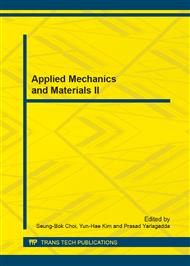p.655
p.660
p.666
p.671
p.675
p.681
p.686
p.690
p.697
Jacking Technology for a Simply Supported Girder Bridge
Abstract:
Numerous bridges have to be lifted to meet increased navigation capacity. However, no relevant technical standard for the jack-up technique is yet available. This paper presents a study on the integral lifting of simply supported girder bridge which implements the finite element method. Finite element analysis provides a reliable basis in controlling construction. Research shows that stress concentration is evident near support points in the lifting process. Thus, stress monitoring is necessary. These points should be near to the bridge web. Moreover, beam span and section rigidity should also be considered when jacking up a bridge. The value of allowable error in the jacking-up process decreases with increasing beam span or decreasing section stiffness. Therefore, jacking up a bridge will be safer when section rigidity is large enough and beam span is not extremely long. This paper offers tremendous reference value with regard to engineering projects.
Info:
Periodical:
Pages:
675-680
Citation:
Online since:
December 2013
Authors:
Price:
Сopyright:
© 2014 Trans Tech Publications Ltd. All Rights Reserved
Share:
Citation:


